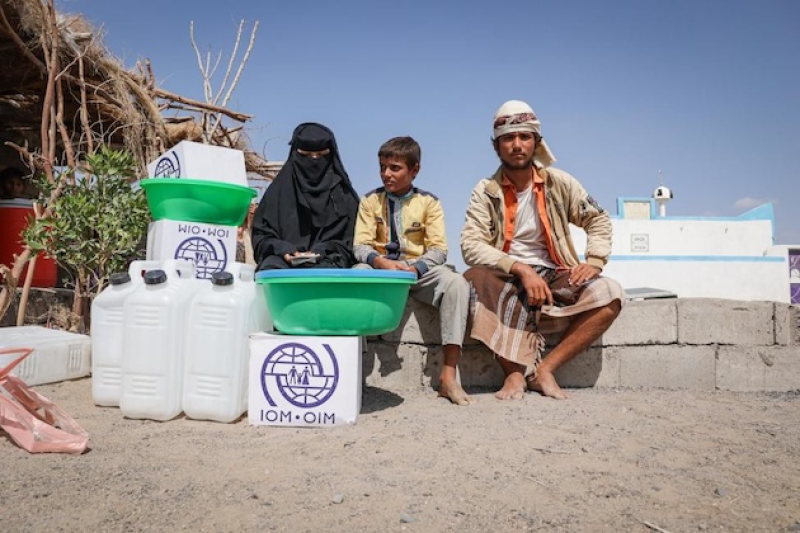- Security Council Divided on United States' Venezuela Action |
- Over 1.53m voters register for postal balloting: Shafiqul Alam |
- Bangladesh Bank to liquidate 9 NBFIs in financial sector reforms |
- Govt Moves to Clear Tk20,000cr Dues to Avoid Summer Outages |
- Maduro Pleads Not Guilty in US Court, Claims Presidency |
Conflict, Climate Drive Migrants in Yemen to Return Home

People in Yemen impacted by war and climate shocks receive aid from the IOM.
Yemen’s humanitarian crisis—driven by conflict, economic collapse, and climate shocks—is leaving migrants desperate to return to their home countries.
In March 2025, the Global Data Institute’s Displacement Tracking Matrix recorded that 1,234 non-Yemeni migrants left the country.
Once a critical transit and destination point, Yemen is now unable to support incoming asylum seekers. Yemenis themselves are struggling to survive amidst a decade-long conflict and worsening climate impacts. Over 4.8 million people are internally displaced, and 20 million rely on humanitarian aid.
Most migrants come from Ethiopia and Somalia, seeking safety or work in Gulf countries. However, many become stranded in Yemen due to harsh conditions and abuse.
The International Organization for Migration (IOM) found that in 2024, around 60,900 migrants arrived in Yemen with no means of survival. These individuals face severe protection risks, including physical and sexual violence, exploitation, abduction, detention, and debt bondage.
“With limited humanitarian resources and few service providers on the ground, migrants often suffer from hunger, untreated medical conditions, and lack of shelter. Many are stranded without access to even the most basic services,” the IOM told IPS.
Meanwhile, public hostility toward migrants has increased, as they are viewed as competing with vulnerable Yemeni populations for scarce aid. The ongoing conflict further compounds these vulnerabilities, with migrants caught in airstrikes, exposed to explosive ordnance, and lacking access to safety.
Women and girls are the most vulnerable migrant group in Yemen, facing a high risk of gender-based and sexual violence.
“I’ve been beaten, detained, and exploited in Yemen,” said a 24-year-old Ethiopian woman to the IOM. “Most nights, I went hungry. After everything that happened to me, I am happy to go back to my home and family.”
Severe climate impacts also hinder access to food and water for both migrants and Yemenis. Around 17.1 million Yemenis suffer from food insecurity, which is worsening due to climate-related challenges.
The June 2025 Migration, Environment, and Climate Change (MECC) Country Report on Yemen by the IOM states that Yemen is the 12th most water-scarce country in the world. This scarcity drives food insecurity as rising temperatures and unpredictable rainfall cause severe droughts and extreme flooding.
In some areas, fertile farmland has turned into arid desert, forcing farmers to switch crops or relocate. In others, heavy rains cause flooding, soil erosion, and the spread of disease through contaminated water.
“Areas that used to experience heavy rainfall now suffer from drought,” said an official from the General Authority for Environmental Protection to the IOM. “Farmers must adapt by planting drought-resistant crops, changing livelihoods, or migrating. Conversely, areas that previously experienced drought are now facing intense rainfall and flood-borne diseases.”
Conflict and lack of basic services significantly restrict migrants' ability to return home. In 2020, the IOM reported that 18,200 people risked their lives travelling by sea. Overcrowded boats often capsize in rough waters, killing many.
For others, returning home means crossing war-torn regions. Without proper assistance, they must navigate dangerous frontlines, risking death from armed violence or landmines.
However, programmes like the IOM’s Voluntary Humanitarian Return (VHR) offer safe passage home. VHR is one of the few solutions for stranded migrants seeking to return voluntarily and with dignity.
So far in 2025, the IOM has helped 66 migrants return safely—a stark drop from 5,200 in 2024.
“IOM provides lifesaving protection and health services through Migrant Response Points (MRPs) in Aden, Sanaa, and Marib, and Community-based Care Centres in Aden and Sanaa. We also operate mobile teams along migratory routes funded by ECHO and UK FCDO,” said the IOM.
“Since 2015, IOM has facilitated VHR as the only viable solution for stranded migrants who wish to return voluntarily, safely, and with dignity.”
The IOM is supported by various partners, including the European Union, the King Salman Humanitarian Aid and Relief Centre (KSrelief), the US State Department’s Bureau of Population, Refugees and Migration, and the governments of Germany, France, Norway, and Finland.
Despite this support, more donations are urgently needed. The IOM is struggling to sustain its efforts due to significant funding cuts.
“As migration flows continue to surge, the demand for safe and dignified return options for migrants has reached critical levels,” said Matt Huber, IOM’s former Chief of Mission in Yemen. “Without immediate funding support, the continuity of this vital programme is at risk, leaving thousands of vulnerable migrants stranded in precarious conditions and exposed to serious protection violations.”

